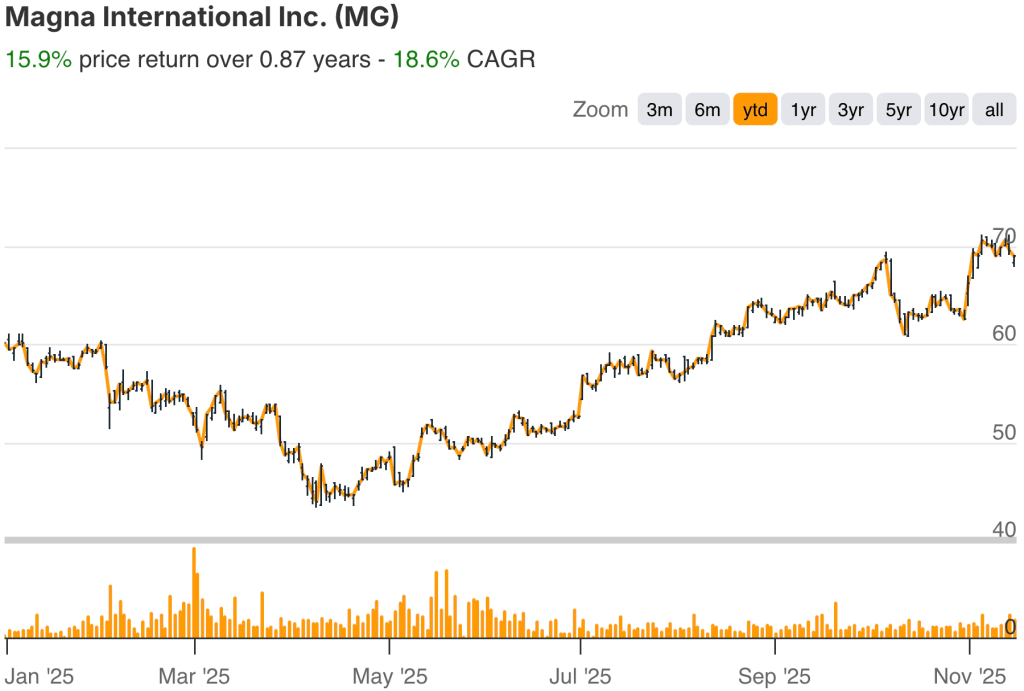Magna International (MG) sits at the center of the global automotive supply chain. The company touches nearly every part of modern vehicle production, from seating systems and body structures to driveline components and complete vehicle assembly. That scale gives Magna a unique advantage across cycles.
When production rises, Magna participates broadly. When production becomes uneven, the company has the diversity to offset softness in one area with strength in another. This makes Magna one of the most important suppliers to watch as the industry recalibrates around electrification, affordability, and changing consumer demand.
Discover how much upside your favorite stocks could have using TIKR’s new Valuation Model (It’s free) >>>
This year gave the company a clearer runway than 2024. North American and European vehicle production improved, helping Magna deliver higher sales and stronger adjusted EBIT. The company focused heavily on cost control, operational efficiency, and better cash conversion. Those efforts translated into one of the strongest quarters of the year, with growth in adjusted diluted EPS, improved margins, and healthy free cash flow. These trends help Magna build a more stable foundation after facing several years of industry volatility.

Investors now want to know whether the progress seen in 2025 can set up a better 2026. The answer lies in two areas. First, the company is tightening execution on new launches and managing input costs more effectively. Second, Magna expanded its backlog with hybrid, EV, and complete-vehicle programs with global automakers, including two China-based OEMs. These wins give the company visibility into future volumes and open the door to new revenue streams. With a steadier production backdrop and improving internal execution, Magna enters 2026 with more momentum than it had a year ago.
Quickly value any stock with TIKR’s powerful new Valuation Model (It’s free!) >>>
Financial Story
Magna delivered 2% year-over-year sales growth in Q3, reaching $10.46 billion. Adjusted EBIT increased 3 percent to 613 million dollars, and adjusted diluted EPS rose 4 percent to 1.33 dollars. These improvements were driven by stronger volumes, better contributions from equity-accounted entities, and continued progress on operational efficiency. The company also delivered better incremental margins than in early 2025, indicating that cost discipline is taking hold.
| Metric | Q3 2025 | YoY Change |
|---|---|---|
| Sales | 10.46B | +2% |
| Adjusted EBIT | 613M | +3% |
| Adjusted EBIT Margin | 5.9% | +10 bps |
| Adjusted Net Income | 375M | +6M |
| Adjusted Diluted EPS | 1.33 | +4% |
| Free Cash Flow | 572M | +398M |
| Cash From Operations | 912M | Higher |
| Capital Spending | 267M | Lower |
| Leverage Ratio | 1.88x | Improved |
Cash flow was a clear highlight. Free cash flow rose to 572 million dollars, up from 174 million dollars last year. This improvement reflects stronger earnings, improved working capital performance, and reduced capital spending. Year to date, Magna also improved its leverage position. The company ended Q3 with an adjusted debt-to-adjusted EBITDA ratio of 1.88 times and expects it to fall below 1.7 times by year’s end. This gives Magna more flexibility as it moves further into 2026.
Look up Magna International’s full financial results & estimates (It’s free) >>>
Broader Market Context
Global automotive markets showed moderate improvement through 2025. North American production rose by 6 percent, European production by 4 percent, and Chinese production by 4 percent. These gains supported Magna’s higher sales and helped offset softness in certain product lines. Even with these improvements, the industry continued facing challenges, including uncertain EV adoption, volatile input costs, and cautious consumer demand. Magna’s diversified book of business gave it more stability than suppliers tied to narrower product categories.
At the same time, OEMs continued to push harder on cost recovery, tariff mitigation, and localization. Magna made progress on each of these fronts during the year. The company settled tariff exposure with several OEM customers and remains on track to resolve most of the remaining items. It also continued optimizing its global footprint and controlling launch costs. These shifts help improve the company’s margin profile as it prepares for a more competitive landscape ahead.
1. New Business Wins Strength Future Visibility
Magna secured major wins with China-based OEMs, including XPENG and a second unnamed brand. These programs reinforce Magna’s role in complete vehicle assembly and highlight the company’s capabilities across EV architectures. Production began on one program in 2025, and a second major launch is scheduled for 2026. These wins give Magna exposure to high-growth EV nameplates and expand its position in international markets.
Beyond complete vehicles, Magna also expanded its driveline, hybrid drive, and 800V electrification portfolio. The company launched a new hybrid system with a leading China-based OEM and continued rolling out its mirror-integrated driver and occupant monitoring system. These technology-driven product areas are important because they carry higher margin potential and align with long-term industry trends. They give Magna room to grow even if global vehicle production stays flat.
2. Operational Efficiency Is Improving
This year, Magna emphasized better execution across new launches and ongoing operations. The company continues to streamline facilities, improve productivity, and reduce input cost exposure. These internal improvements contributed to stronger year-over-year EBIT and better incremental margins in Q3. Higher equity income also supported earnings, reflecting improved performance from key joint ventures.
Looking into 2026, efficiency remains one of the company’s best tools for improving profitability. While labor and input costs continue to rise, Magna has shown progress recovering these costs through pricing and commercial adjustments. The company still faces pressure in certain segments, but the broader trend shows better control over expenses. As these improvements build, margin stability becomes more achievable.
Value stocks like Magna International in less than 60 seconds with TIKR (It’s free) >>>
3. Free Cash Flow Strength Supports Financial Flexibility
Free cash flow was one of Magna’s standout achievements in Q3. The company generated 572 million dollars, up sharply from last year. Lower capital spending contributed to this improvement, and Magna now expects to finish 2025 with capital spending of about 1.5 billion dollars, down from earlier estimates. This reduction supports better cash conversion at a time when global markets remain uncertain.
Heading into 2026, a stronger cash position gives Magna more options. The company highlighted its intention to maintain disciplined capital allocation, focusing on debt reduction and select investments. Magna also renewed its buyback authorization, effective until 2026, which provides optionality if market conditions improve. This financial flexibility becomes an integral part of the company’s long-term story.
The TIKR Takeaway

TIKR shows a company gaining momentum after a period of volatility. Magna’s multi-year financial profile highlights steady sales growth, improving margins, and better cash conversion. Investors can see how new business wins, cost discipline, and a clearer production outlook shape a more stable runway. When viewed through TIKR’s long term charts, Magna appears positioned for a smoother performance cycle as it moves into 2026.
Should You Buy, Sell, or Hold Magna International’s Stock in 2025?
The company’s improving cash flow, stronger margin profile, and expanding pipeline give it more balance than it had earlier in the cycle. Risks remain, including EV demand uncertainty and tariff exposure, but the company appears to be moving in the right direction as it prepares for 2026.
How Much Upside Does Magna International Stock Have From Here?
With TIKR’s new Valuation Model tool, you can estimate a stock’s potential share price in under a minute.
All it takes is three simple inputs:
- Revenue Growth
- Operating Margins
- Exit P/E Multiple
If you’re not sure what to enter, TIKR automatically fills in each input using analysts’ consensus estimates, giving you a quick, reliable starting point.
From there, TIKR calculates the potential share price and total returns under Bull, Base, and Bear scenarios so you can quickly see whether a stock looks undervalued or overvalued.
See a stock’s true value in under 60 seconds (Free with TIKR) >>>
Looking for New Opportunities?
- See what stocks billionaire investors are buying so you can follow the smart money.
- Analyze stocks in as little as 5 minutes with TIKR’s all-in-one, easy-to-use platform.
- The more rocks you overturn… the more opportunities you’ll uncover. Search 100K+ global stocks, global top investor holdings, and more with TIKR.
Disclaimer:
Please note that the articles on TIKR are not intended to serve as investment or financial advice from TIKR or our content team, nor are they recommendations to buy or sell any stocks. We create our content based on TIKR Terminal’s investment data and analysts’ estimates. Our analysis might not include recent company news or important updates. TIKR has no position in any stocks mentioned. Thank you for reading, and happy investing!








